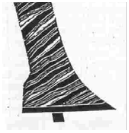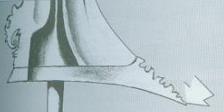|
B |
Brongsong (1)or Brongsongan is a kind of like Posh carry the keris in Surakarta and surrounding area. The keris is in a pocket, called Singep. The keris is then inserted in between the second and third wrapping of the cloth Sabuk Lontong and front worn across his chest. It is held with the right hand. Lower Stands may not see the keris and the blade must not be removed from the warangka. Only nationals of the upper classes may do so.
|

Brongsong (2)is part of a tombak and is normally made of brass or silver. It can be found on the handle near the top (towards the blade) and covers the Pesi of Tombak. This part is called in other areas also Blongsong, Karah Tombak or Srumbung.
|

Brunei, KerisThere are two forms of krisses. First, the keris before the Second World War (Japanese occupation in 1941), secondly Keris after 1983. Between 1941 and 1983 no keris were manufactured. The ancient krisses were manufactured in the territory Muara, Bandar Sri Begawan until the 20's of the 20th century and had the shape of a Bugis-Keris, many came from Bugis to Brunei. In 1983 the production of krisses was resumed and they have since than the form of Malaysian Keris, as the government had set a kriss teacher from Malaysia. Employee at the sultan's palace |

Buah Mancang, Sampiris a form of vampire (body Awak-Awak Waranga) or keris sheath in Jazirah Malaysia. There are still other forms like Sari Bulan and Hari Dua Bulan. |

|
Bugis, Keris see Sulawesi, Keris |
|
Bulotado is a Tombak is to hunt a deer or wild pigs in South Sulawesi. The blade is made of iron and 12 to 14 inches (30 to 35) cm long. The handle is made of wood or bamboo pole. |
|
Bulu Ayam is in parts of East Java and Madura the name for a pamor motive. It belongs to pamor Miring. They divided this pamor among others into pamor Blarak Ngirid, Ri Wader, Ron Genduru Read more here.
From left to right: Sekar Gelagah, Eri (Ri) Wader and Ron Genduru
|

|
Bunga Saka-Sakah is the form of a handle, which has already become quite rare in Brunei, Sabah and Malaysia. It has the shape of a blooming Sakah-Sakah flower. |

|
Bunga Silat is the shape of a handle in Brunei. It has a Balong. This handle was formerly used by sailors and military personnel of the Sultanate. It is still known in Brunei and Malaysia. |

|
Bung Ampel or Bong Ampel is a Dapur for straight Tombak. The blade is sharp and symmetrical. The blade has a waist, called Bangkekan. The upper portion above the waist is wider than the lower part. The indicator below are parts that look like little sting. Bung Ampel is a not too old Dapur. The first Tombak dated from the era of the sultans of Mataram. The name comes from Bambu Ampel (bamboo plant). |

|
Bungkalan or Belah Pucuk is a pamor for krisses and Tombak, see more info here. |

|
Bungkul or Bawang Sebungkul or Bongkol, Wungkul or Genukan is a part of the blade at the bottom in the middle. The shape looks like an onion. The Bungkul be found at krisses and Tombak. |


|
Bungkus is a pamor motive which can be found at the bottom of the Sor-Soran. This pamor motive looks like between Wos Wutah and Ngulit Semongko. It's not a selected pamor motive. It belongs to Mlumah and Rekan. Read more here. |

|
Buntel Mayit is a pamor motive. You can reed more here. |

|
Bunton, Pendok is a part made of metal to cover the gandar the Waranga. The pendok may be made of gold, silver, brass or other metal. A pendok Bunton covers the gandar completely, so that no timber can be seen. It serves the warangka reinforce or conceal bad wood. This type of pendok is found in Surakarta and Yogyakarta, but more often in Surakarta. This type of pendok can also be found in Bali and Bugis. |


|
Surakarta |




|
Yogyakarta |
|
v. l. n. r.: Bali, Bugis, Banyumas |
|
Buntut or Buntut Sarung Keris is used by the inhabitants of Riau, Malaysia and West Borneo. It is a piece of the lower part of the sheath. In Java you call this part also gandar Antup-Antupan. There are two forms.
Buntut in Malaysia and Brunei |

|
Buntut Cecak or Buntutan or Kepet is part of the tip of the Ganja. |

|
Buntut Mimi is the part at the very tip of a Ganja of a keris with Greneng or Ri Pandan and sharp. |

|
Busur is the most important part of an arc. It is made of wood or bamboo and the two points are connected by a thread which stretched the bow and arrows are shot. In some areas the sheet is 40 to 50 inches (100 to 125 cm) tall, in Irian Jaya and the surrounding area even 60 to 70 inches (150 to 175 cm). The timber must be strong.
Three kinds of a bow |

|
Buta Ijo is a Dapur of a keris with 9 Luk and very rare. The blade is very long and has an Ada-Ada. It has a Sogokan and Ri Pandan. Previously the soldiers of the palace wear krisses with this pamor. The translation means Green Giant. This can be found in the stories of giants in Javanese tales. |

|
Buta Meler is a Dapur of a Tombak with 3 Luk. The blade is approx. 10 inches (25 cm) long. It has an Ada-Ada and at the Sor-Soran a small Bungkul. This Dapur has a Greneng. It is an old Dapur of a Tombak and usually come from the Tangguh Mataram Sultan Agung. |





